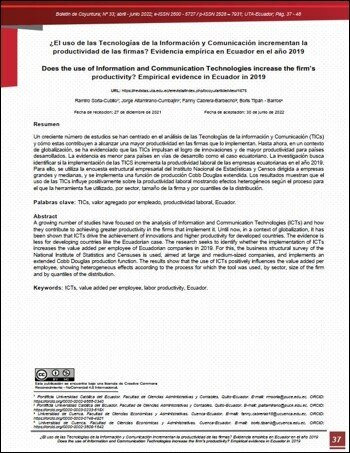Does the use of Information and Communication Technologies increase the firm’s productivity? Empirical evidence in Ecuador in 2019
Main Article Content
Abstract
A growing number of studies have focused on the analysis of Information and Communication Technologies (ICTs) and how they contribute to achieving greater productivity in the firms that implement it. Until now, in a context of globalization, it has been shown that ICTs drive the achievement of innovations and higher productivity for developed countries. The evidence is less for developing countries like the Ecuadorian case. The research seeks to identify whether the implementation of ICTs increases the value added per employee of Ecuadorian companies in 2019. For this, the business structural survey of the National Institute of Statistics and Censuses is used, aimed at large and medium-sized companies, and implements an extended Cobb Douglas production function. The results show that the use of ICTs positively influences the value added per employee, showing heterogeneous effects according to the process for which the tool was used, by sector, size of the firm and by quantiles of the distribution.
URL: https://revistas.uta.edu.ec/erevista/index.php/bcoyu/article/view/1675
Downloads
Article Details

This work is licensed under a Creative Commons Attribution-NonCommercial 4.0 International License.
![]()
The publications of the Boletín de Coyuntura are licensed under a Creative Commons Attribution-NonCommercial 4.0 International License (CC BY-NC 4.0). The Universidad Técnica de Ambato retains the copyright of the published works, and favors and allows the reuse of these, as long as: the authorship and original source of publication is cited, and they are not used for commercial or onerous purposes. The intellectual property of the published articles belongs to the authors.
References
Abramova, N., & Grishchenko, N. (2020). ICTs, Labour Productivity and Employment: Sustainability in Industries in Russia. Procedia Manufacturing, 299-305.
Aghion, P., Blundell, R., Griffith, R., Howitt, P., & Prantl, S. (2004). Entry and Productivity Growth: Evidence from Microlevel Panel Data. Journal of the European Economic Association, 265-276.
Alderete, M., & Gutiérrez, L. (2012). TIC y productividad en las industrias de servicios en Colombia. Scielo, 163-188.
Arendt, L., & Grabowski, W. (2017). Innovations, ICT and ICTdriven labour productivity in Poland. Economics of Transition, 723-758.
Arévalo, D., Nájera, S., & Piñero, E. (2018). La Influencia de la Implementación de las Tecnologías de Información en la Productividad de Empresas de Servicios. Scielo, 199-212.
Ballestar, M., Díaz, Á., Sainz, J., & Torrent-Sellens, J. (2020). Knowledge, robots and productivity in SMEs: Explaining the second digital wave. Journal of Business Research, 119-131.
BCE. (Marzo de 2021). Banco Central del Ecuador. Fonte: BCE: https://contenido.bce.fin.ec/documentos/PublicacionesNotas/BOLETIN382021.pdf
Brosi, B., & Biber, E. (2009). Statistical inference, Type II error, and decision making under the US Endangered Species Act. Frontiers in Ecology and the Enviroment, 487-494.
Brynjolfsson, E., & Hitt, L. (2003). Computing Productivity: Firm-Level Evidence. EconPapers, 793-808.
Cameron, C., & Trivedi, P. (2009). Microeconometrics Using Stata. Texas: StataCorp LP.
Cobo, J. (2009). El concepto de tecnologías de la información. Benchmarking sobre las definiciones de las TIC en la sociedad del conocimiento. Revista De Estudios De Comunicación = Komunikazio Ikasketen Aldizkaria, 295-318.
Crepon, B., Duguet, E., & Mairesse, J. (1998). Research, Innovation, and Productivity: an Econometric Analysis at the Firm Level. SSRN, 1-44.
Dendrick, J., Kraemer, K., & Shin, E. (2014). Information technology and productivity in developed and developing countries. Jornal of Management Information Systems, 97/122.
Dewan, S., & Kraemer, K. (2000). Information Technology and Productivity: Evidence from. Managment Science, 548-562.
Draca, M., Sadu, R., & Van Reeen, J. (2006). Productivity and ICT: A Review of the Evidence. Centre for Economic Performance, 1-76.
Gálvez, E., Riascos, S., & Contreras, F. (2014). Influencia de las tecnologías de la información y comunicación en el rendimiento de las micro, pequeñas y medianas empresas colombianas. Science Direct, 355-364.
Gordon, R. (1999). Has the “New Economy” Rendered the Productivity Slowdown Obsolete? University Northwestern, 1-37.
Hawash, R., & Guenter, L. (2020). Does the digital gap matter? Estimating the impact of ICT on productivity in developing countries. Eurasian Economic Review, 189-209.
Herman, E. (2020). The Influence of ICT Sector on the Romanian Labour Market in the European Context. Procedia Manufacturing, 344-351.
Hitt, L., & Brynjolfsson, E. (1996). Productivity, Business Profitability, and Consumer Surplus: Three Different Measures of Information Technology Value. MIS Quarterly, 121-142.
INEC. (2019). Instituto Nacional de Estadística y Censos. Fonte: INEC: https://www.ecuadorencifras.gob.ec/encuesta-a-empresas/
Johansson, B., & Loof, H. (2015). Productivity, networks and knowledge flows. Economics of Innovation and New Technology, 1-4.
Jorgenson, D. (2001). Information Technology and the U.S. Economy. American Economic Review, 1-32.
Keller, W., & Ross, S. (2013). The Gravity of Knowledge. American Economic Review, 1414-1444.
Kijek, T., & Kijek, A. (2019). Is innovation the key to solving the productivity paradox? Journal of Innovation & Knowledge, 219-225.
Litardo, J., & Santana, L. (2019). Análisis de inversión en las TIC y su relación con la productividad en las Pymes del sector textil a nivel nacional. Guayaquil, Ecuador: Universidad Católica de Santiago de Guayaquil. Fonte: http://201.159.223.180/bitstream/3317/13584/1/T-UCSG-PRE-ECO-ADM-519.pdf
Mcbride, G. (2003). Applications: Equivalence Tests Can Enhance Environmental Science and Management. Australian & New Zealand Journal of Statistics, 19-29.
Mekala, K., Mischke, J., & Remes, J. (2018). Is the Solow Paradox back? The McKinsey Quarterly, 1-4.
OECD. (8 de Agosto de 2002). Organización para la Cooperación y el Desarrollo Económicos. Fonte: OECD: https://stats.oecd.org/glossary/detail.asp?ID=4819
Oulton, N. (2001). ICT and productivity growth in the United Kingdom. Bank of England, 1-77.
Porter, M., & Millar, V. (1985). How Information Gives You Competitive Advantage. Harvard Business Review, 149-160.
Ta?tan, H., & Feride, G. (2020). ICT labor, software usage, and productivity: firm-level evidence from Turkey. Journal of Productivity Analysis, 265-285.
Villavicencio, K. (2021). Influencia de las Tics en la productividad de las empresas del Sector Manufacturero de Manabí. Guayaquil, Ecuador: Universidad Católica de Santiago de Guayaquil. Fonte: http://201.159.223.180/bitstream/3317/16285/1/T-UCSG-PRE-ECO-ADM-583.pdf
Zhang, H., Wei, Y., & Ma, S. (2021). Overcoming the “Solow paradox”: Tariff reduction and productivity growth of Chinese ICT firms. Journal of Asian Economics, 74-88.


